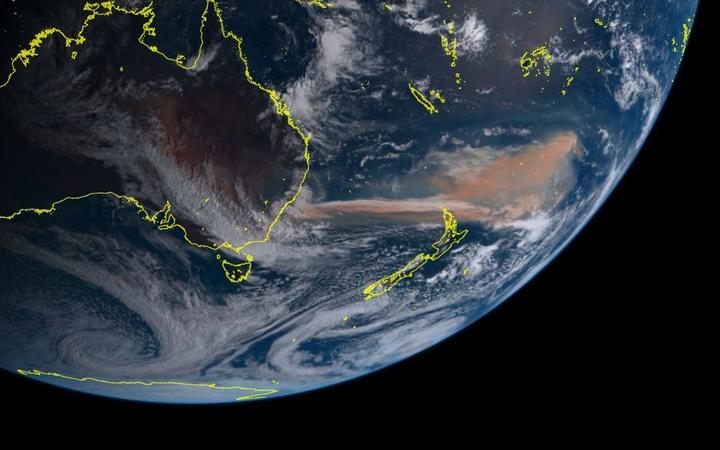
At least 24 people have died since Australia's bushfires began in September last year. Air quality in the capital, Canberra, was this weekend rated the worst in the world.
Soaring temperatures on Saturday gave way to a cooler change on Sunday, giving firefighters a little breathing room, but the situation promises to worsen as the heat returns later in the week.
More than 2000km away, New Zealand has over the past week seen strange, smoky, orange skies overhead.

"If you look, there's some beautiful satellite imagery taken by the Japanese meteorological satellite Himawari ... it captures an image of the entire hemisphere and you can see this stream of smoke in the atmosphere working its way from the east coast of Australia across New Zealand and out into the Pacific."
He said he thought the smoke was unlikely to have dramatic health effects for New Zealanders, but vulnerable people should take care.
"I think that for most people in New Zealand it won't be a huge issue."
Science educator, Nanogirl Michelle Dickinson produced a handy video explaining how it all works.
WHAT CAUSES THE ORANGE GLOW?
Prof Easther said he was in Hauraki Gulf and Auckland on Sunday people were driving around with their lights on at 5pm.
"Maybe about two or three o'clock in the afternoon it started to get dark and kind of orangey, so both the intensity and the colour of the light changed quite dramatically and quite quickly," he said.
He said while he had never seen anything like it in Auckland before, the orange-red glow was caused by the smoke obscuring blue light.
"Simply, because it's between us and the sun. In general what happens is that shorter wavelengths of light are more affected by longer wavelengths by this sort of material and you see it in astrophysics as well - I mean there's a lot of dust in the galaxy, so things look redder if you're seeing them through dust."
Prof Easther said UV is a shorter wavelength than blue light - so it would actually help reduce sun exposure. On the other side of the ledger, he warned that vulnerable people - children, the elderly and the sick - should take care.
It's smoke, the end product of combustion that were produced in the Australian fires.
"In Australia at the moment in Canberra its easily the world's most polluted city and major institutions there have closed down so it is conceivable that people in New Zealand, particularly vulnerable people, might feel some effect. But, by and large no," he said.
"In some cases people have smelt it so in some cases so it definitely extends to ground level.
"I think some people have reported that they've had asthma attacks induced by the particulate pollution that's associated with the bushfires."
He said he did not think it was likely to have much effect on plant life, but said that was not his area of expertise.
"Certainly there are images from the snow-covered parts of the South Island showing the snow has been stained orange by the ash, so it's clear that this material is reaching the ground and having an impact.
"Whether there's enough of it or ... whether it would harm plants - I'd be inclined to say 'no' at a guess. But, you know, if you're drinking water that hasn't been treated and is coming out of a stream at the very least I'd be doing some Googling.
"In principle, anything that reduces the amount of light reaching the ground is going to change the way that plants respond.
"Given that the intensity of the fires changes as a function of time - and also it depends on the wind being in the right direction for it to cross the Tasman and impact New Zealand - so I think it's unlikely to have a major impact on New Zealand in terms of growing."
WILL THE HAZE CONTINUE?
Prof Easther said it was uncertain whether the fires would continue to blanket New Zealand in smoke, depending on the wind strength and direction.
"There are reasonably strong winds in the atmosphere and so it moves relatively quickly ... but on the other hand as long as the fires continue to burn in Australia it's entirely conceivable that we'll have more days like this, this summer.
"This fire season is apparently unusual in that it got started early - normally the fires are worse in February - so anyway it's easy to imagine that Australia has another two months of fire ahead of it."
Australian Prime Minister Scott Morrison has warned the fires could continue for months.












